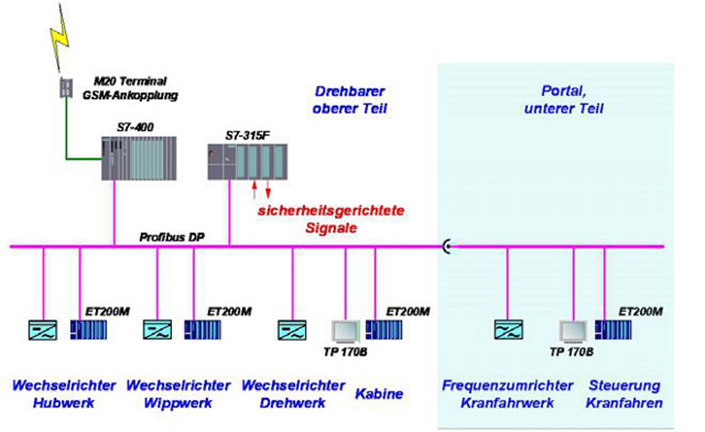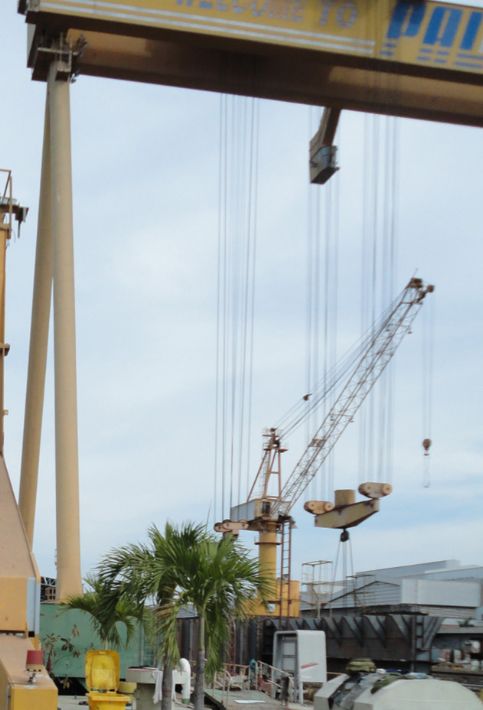Three shipyard cranes were electronically modernised on a shipyard . The cranes in question are two slewing cranes and a gantry crane. They are used in the dock areas for shipbuilding.
The slewing cranes

The cranes are equipped with a hoisting gear, a luffing gear, slewing gear and a travelling gear. All drives have three-phase current squirrel-cage motors which are supplied via frequency converters.
The precise adjustment of the individual crane movements, its reliability and robustness are important attributes of the crane.
Additionally, safety plays an important part for the operating personnel and the equipment alike.
The drive and control concept

The crane is supplied via a 6000 V medium voltage line (high voltage cable) that is wound up with a spiral-winding high voltage cable reel. The power is then supplied to the 400 V low-voltage distributor via a high voltage transformer.
The power electronics comprise an “active front-end unit” (AFE) as the feed and re-generating feed unit, a DC busbar and inverters.A S7-400 is used as the controller and this communicates with the power electronics via a Profibus-DP. In addition to this powerful controller, a failsafe PLC S7-315F is integrated for the safety-relevant signals.This configuration provides a clear and reliable system structure ensuring easy maintainability. Additionally, the system is highly efficient because the braking energy is fed back into the power network.
Totally Integrated Automation
The logical networking of the system components via the Profibus-DP allows information to flow from the individual sensors, master controllers and frequency converters to the controller and back. System messages and changes to the parameters are possible via a “Touch screen” TP170B.
With the aid of a modem connected to the PLC, it is also possible to perform a remote diagnosis.
Monitoring by failsafe PLC

Another important criterion of this system is the safety concept. Overriding safety functions are implemented with a failsafe PLC type S7-315F from Siemens. This PLC, as described previously, is connected to the S7 - 400 via a Profibus-DP and monitors all safety-relevant functions such as emergency stop signals, emergency limit switches, overload signals etc.
This concept guarantees that the actual functions of the equipment are ensured through the powerful S7-400 with a high level of flexibility, and also that a clear structure has been configured through the limited extent of programming in the failsafe S7-315 F. It must also be pointed out that the failsafe signals are processed via the Profibus-DP and decentralised interface modules. The inflexible, hard-wired emergency-off switches or the redundant and complex configuration of non-safety-relevant PLCs with the corresponding confusing program structures have become a thing of the past with this concept.
The gantry crane

The special feature of the gantry crane is its equipment with two trolleys and three hoist units. This fact makes it possible to horizontally turn individual ship segments and position them. We were tasked with modernizing the controls of the hoist units, the trolleys and the drive units. The focus was on the controlling of the hoist units and the drive units using synchronization control. For the controls a PLC S7-400 was utilized.
A Ward Leonard converter was used for the motor speed control. A Ward Leonard converter operates with a primary drive which powers a DC generator at a constant speed. The speed regulation is effected through the changing of the exciting current on the generator.
Why HIT?
HIT has implemented these modernization to the full satisfaction of our customers. From the very beginning, the system proved its reliability. Through the high control performance of the drives, we were able to improve the handling compared to the previous equipment and a high standard of safety has been achieved.